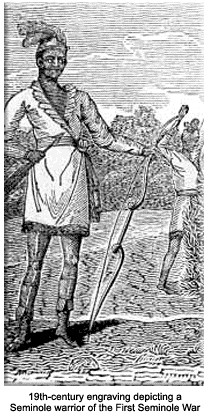In the early 18th century, bands of Muskogean-speaking Lower Creek migrated to Florida from Georgia. They became known as the Seminole (literally "separatists"). Floridian territory was nominally under Spanish sway; the Spanish permitted the Seminole to settle there in order to create a buffer zone between their sphere of influence and that of the British.
 The natives occupied rich lands in northern Florida that were hungrily eyed by American settlers in adjacent Georgia, although Florida still belonged to Spain at the beginning of the 19th century. Another cause of potential conflict was the Seminole tendency to provide refuge to runaway slaves.
While the United States was fighting the War of 1812 with Britain, a series of violent incidents aggravated hostility between the U.S. and the Seminole.
The First Seminole War erupted over forays staged by U.S. authorities to recapture runaway black slaves living among Seminole bands, who stiffly resisted. In 1818, Major General Andrew Jackson was dispatched with an army of more than 3,000 soldiers to Florida to punish the Seminole. After liquidating several native settlements, then executing two British traders (Arbuthnot and Ambrister) held for reportedly encouraging Seminole resolve, General Jackson captured the Spanish fort of Pensacola in May 1818 and deposed the government. However, he failed to snuff out Seminole opposition. Two more wars ensued (1835-1842), (1855-1858), which ultimately resulted in confiscation of the Seminoles' land for white settlement and exploitation.
The natives occupied rich lands in northern Florida that were hungrily eyed by American settlers in adjacent Georgia, although Florida still belonged to Spain at the beginning of the 19th century. Another cause of potential conflict was the Seminole tendency to provide refuge to runaway slaves.
While the United States was fighting the War of 1812 with Britain, a series of violent incidents aggravated hostility between the U.S. and the Seminole.
The First Seminole War erupted over forays staged by U.S. authorities to recapture runaway black slaves living among Seminole bands, who stiffly resisted. In 1818, Major General Andrew Jackson was dispatched with an army of more than 3,000 soldiers to Florida to punish the Seminole. After liquidating several native settlements, then executing two British traders (Arbuthnot and Ambrister) held for reportedly encouraging Seminole resolve, General Jackson captured the Spanish fort of Pensacola in May 1818 and deposed the government. However, he failed to snuff out Seminole opposition. Two more wars ensued (1835-1842), (1855-1858), which ultimately resulted in confiscation of the Seminoles' land for white settlement and exploitation.